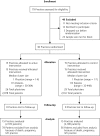Translating cholesterol guidelines into primary care practice: a multimodal cluster randomized trial
- PMID: 22084264
- PMCID: PMC3252191
- DOI: 10.1370/afm.1297
Translating cholesterol guidelines into primary care practice: a multimodal cluster randomized trial
Erratum in
- Ann Fam Med. 2012 Mar-Apr;10(2):179
Abstract
PURPOSE We wanted to determine whether an intervention based on patient activation and a physician decision support tool was more effective than usual care for improving adherence to National Cholesterol Education Program guidelines. METHODS A 1-year cluster randomized controlled trial was performed using 30 primary care practices (4,105 patients) in southeastern New England. The main outcome was the percentage of patients screened for hyperlipidemia and treated to their low-density lipoprotein (LDL) and non-high-density lipoprotein (HDL) cholesterol goals. RESULTS After 1 year of intervention, both randomized practice groups improved screening (89% screened), and 74% of patients in both groups were at their LDL and non-HDL cholesterol goals (P <.001). Using intent-to-treat analysis, we found no statistically significant differences between practice groups in screening or percentage of patients who achieved LDL and non-HDL cholesterol goals. Post hoc analysis showed practices who made high use of the patient activation kiosk were more likely to have patients screened (odds ratio [OR] = 2.54; 95% confidence interval [CI], 1.97-3.27) compared with those who made infrequent or no use. Additionally, physicians who made high use of decision support tools were more likely to have their patients at their LDL cholesterol goals (OR = 1.27; 95% CI, 1.07-1.50) and non-HDL goals (OR = 1.23; 95% CI, 1.04-1.46) than low-use or no-use physicians. CONCLUSION This study showed null results with the intent-to-treat analysis regarding the benefits of a patient activation and a decision support tool in improving cholesterol management in primary care practices. Post hoc analysis showed a potential benefit in practices that used the e-health tools more frequently in screening and management of dyslipidemia. Further research on how to incorporate and increase adoption of user-friendly, patient-centered e-health tools to improve screening and management of chronic diseases and their risk factors is warranted.
Trial registration: ClinicalTrials.gov NCT01242319.
Figures





References
-
- Rosamond W, Klegal K, Friday G, et al. Heart disease and stroke statistics, 2007 update: a report from the American Heart Association Statistics Committee and Stroke Statistics Subcommittee. Circulation. 2007;115: e69–e171 - PubMed
-
- US Department of Health and Human Services; National Institutes of Health; National Heart Lung and Blood Institute Third Report of the National Cholesterol Education Program (NCEP) Expert Panel on Detection, Evaluation and Treatment of High Blood Cholesterol in Adults (Adult Treatment Panel III) Final Report. Heart Lung and Blood Institute, NIH Publication No. 02-5125; 2002
-
- Grundy SM, Cleeman JI, Merz LNHeart, Lung and Blood Institute; American College of Cardiology Foundation; American Heart Association Implications of recent clinical trials for the National Cholesterol Program Adults Treatment Panel III Guidelines. Circulation. 2004;110(2)227–239 - PubMed
-
- Pearson TA, Laurora I, Chu H, Kafonek S. The lipid treatment assessment project (L-TAP): a multicenter survey to evaluate the percentages of dyslipidemic patients receiving lipid-lowering therapy and achieving low-density lipoprotein cholesterol goals. Arch Intern Med. 2000;160(4):459–467 - PubMed
-
- Bertoni AG, Bonds DE, Steffes S, et al. Quality of cholesterol screening and management with respect to the National Cholesterol Education’s Third Adult Treatment Panel (ATP III) guideline in primary care practices in North Carolina. Am Heart J. 2006;152(4):785–792 - PubMed
Publication types
MeSH terms
Substances
Associated data
Grants and funding
LinkOut - more resources
Full Text Sources
Medical
